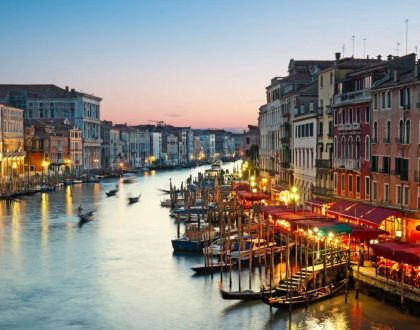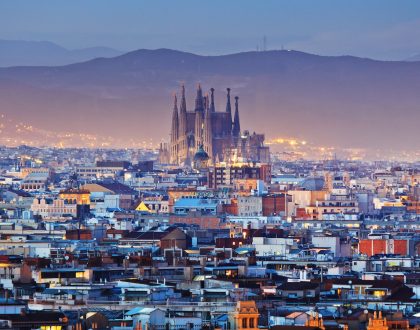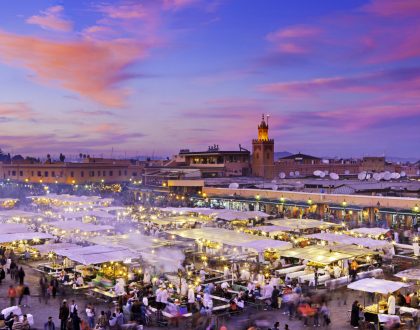Things to Do in Rome

by myreserva
In a city so filled with icons of antiquity and the Christian faith, it’s hard to know where to go first. Of course, your own interests will govern your choices, but there are certain sites that are almost obligatory landmarks of Italy and of all Europe, such as the Colosseum and the Pantheon. A word of caution: try to vary your experiences as you explore Rome, so that you don’t visit too many ancient sites or churches in a row. And intersperse these more serious attractions with a few that are simply tourist icons – the Spanish Steps and that place all tourists must go to toss in their coin, the Trevi Fountain. Rome is so big that it can overwhelm, so even the most devoted sightseer should take some time to kick back and enjoy la dolce vita in a park or sidewalk café.
1 The Colosseum and the Arch of Constantine
As the Eiffel Tower is to Paris, the silhouette of the Flavian Amphitheatre is to Rome. The largest structure left to us by Roman antiquity, the Colosseum still provides the model for sports arenas – present day football stadium design is clearly based on this oval Roman plan. The building was begun by Vespasian in AD 72, and after his son Titus enlarged it by adding the fourth story, it was inaugurated in the year AD 80 with a series of splendid games. The Colosseum was large enough for theatrical performances, festivals, circuses, or games, which the Imperial Court and high officials watched from the lowest level, aristocratic Roman families on the second, the populace on the third and fourth.
Beside the Colosseum stands the almost equally familiar Arch of Constantine, a triumphal arch erected by the Senate to honor the emperor as “liberator of the city and bringer of peace” after his victory in the battle of the Milvian Bridge in 312.
2 Vatican City
The Vatican is the smallest independent state in the world, with an area of less than half a square kilometer, most of it enclosed by the Vatican walls. Inside are the Vatican palace and gardens, St. Peter’s Basilica, and St. Peter’s Square, an area ruled by the Pope, supreme head of the Roman Catholic Church. This compact space offers much for tourists to see, between its museums and the great basilica itself.
Inside St. Peter’s Basilica is Michelangelo’s masterpiece, Pieta, along with statuary and altars by Bernini and others. The unquestioned highlight of the Vatican museums is the Sistine Chapel, whose magnificent frescoed ceiling is Michelangelo’s most famous work. Inside the Vatican Palace are the Raphael Rooms, the Borgia Apartments, the Vatican Library, and a number of museums that include the Picture Gallery, Museum of Secular Art, Etruscan Museum, and others. The collections you can see in these cover everything from papal coaches to 20th-century art reflecting religious themes.
3 The Pantheon
The Pantheon – the best preserved monument of Roman antiquity – is remarkably intact for its 2000 years. This is despite the fact that Pope Gregory III removed the gilded bronze roof tiles, and Pope Urban VIII ordered its bronze roof stripped and melted down to cast the canopy over the altar in St. Peter’s and cannons for Castel Sant’Angelo. The Pantheon was rebuilt after damage by fire in AD 80, and the resulting brickwork shows the extraordinarily high technical mastery of Roman builders. Its 43-meter dome, the supreme achievement of Roman interior architecture, hangs suspended without visible supports – these are well hidden inside the walls – and its nine-meter central opening is the building’s only light source. The harmonious effect of the interior is a result of its proportions: the height is the same as the diameter. Although the first Christian emperors forbade using this pagan temple for worship, in 609 Pope Boniface IV dedicated it to the Virgin and all the Christian martyrs, and since then, it has become the burial place of Italian kings (Victor Emmanuel II is in the second niche on the right) and other famous Italians, including the painter Raphael.
4 Roman Forum
Walking through the forum, now in the middle of a throbbing modern city, is like stepping back two millennia into the heart of ancient Rome. Although what survives of this center of Roman life and government shows only a small fraction of its original splendor, the standing and fallen columns, its triumphal arches, and remains of its walls still impress, especially when you consider that for centuries, the history of the Forum was the history of the Roman Empire and of the western world. Roman political and religious life was centered here, along with the courts, markets, and meeting places. After the seventh century, the buildings fell into ruin, and churches and fortresses were built amid the ancient remains. Its stones were quarried for other buildings and it was not until the 18th and 19th centuries that systematic excavations brought the ancient buildings to light from under a 10-meter layer of earth and rubble. Highlights not to miss are the Temple of Antoninus Pius, the Temple of Castor and Pollux, the Temple of Saturn, the Arch of Septimus Severus, the Curia, the Temple of Vesta, and the Arch of Titus.
5 Trevi Fountain
One of the city’s most popular tourist attractions, this 17th-century masterpiece has been immortalized in films until it is almost a required visit. Throwing a coin (not three) into the Trevi Fountain (Fontana di Trevi) is a tradition that is supposed to assure your return to Rome. Rome’s largest fountain, Fontana di Trevi is supplied by an aqueduct originally constructed by Agrippa, the great art patron of the first century BC, to bring water to his baths. The fountain was created for Pope Clement XII between 1732 and 1751 by Nicolò Salvi, and built against the rear wall of the palace of the Dukes of Poli. It depicts the sea god Oceanus (Neptune), with horses, tritons, and shells. The water swirls around the figures and the artificial rocks, and collects in a large basin, always filled with coins.
6 San Giovanni in Laterano (Basilica of St. John Lateran)
As you might expect for the episcopal church of the Pope, St. John Lateran is one of Rome’s most impressive churches. After centuries of alterations, it still retains its original form from the age of Constantine, when it was built. Its façade, by contrast, is a purely baroque embellishment and a fine example of that period. Along with the mosaics in the apse, be sure to notice the beautiful 16th-century wooden ceiling. If the octagonal baptistery, San Giovanni in Fonte, looks a bit familiar, it’s because it provided the model for later ones throughout Europe. Built by Constantine, it is the world’s oldest Christian baptistery. Across the piazza, in the church of the Scala Santa, is the Holy Staircase, 28 steps believed to have been brought to Rome in the fourth century by St. Helen, from Pilate’s palace in Jerusalem.
7 The Spanish Steps
Ironically, the flight of irregular stairs and landings called the Spanish Steps (Scalinata della Trinità dei Monti) were paid for by the French ambassador and lead up to the French church of Trinità dei Monti. The stairs, however, take their name from Piazza di Spagna, the plaza at their base and one of Rome’s most typical squares. The stairs have been a favorite haunt of tourists, where they can sit and enjoy a gelato in the summer or warm their hands around cones of hot roasted chestnuts in the winter. The boat-shaped fountain at the foot of the Spanish Steps is known as the Barcaccia and was created by Pietro Bernini, father of the great Baroque architect Gian Lorenzo Bernini. Trinità dei Monti, begun by Louis XII in 1502, still preserves some of the original Gothic arches and contains an Entombment by Daniele da Volterra, student of Michelangelo. Via Condotti, leading southwest from Piazza di Spagna, is Rome’s most fashionable shopping street, where the Caffè Greco is famous for the artists, writers, and musicians who have frequented it. Literary fans can visit the House of Keats and Shelley to see exhibits and portraits of the English poets and their contemporaries.
8 The Catacombs and Via Appia Antica (Appian Way)
The Catacombs of San Callisto (St. Calixtus) and San Sebastiano, both underground burial places in the Via Appia Antica, are extensive – San Callista fills an area of 300 by 400 meters — with intricate multi-layered networks of passages and chambers carved into the soft tufa. In addition to the tombs, St. Calixtus has six sacramental chapels, constructed between 290 and 310, with both pagan and early Christian wall paintings. In the Papal Crypt are the tombs of most of the martyred Popes of the third century identified by Greek inscriptions. San Sebastiano, one of Rome’s seven pilgrimage churches, was built in the fourth century on the site of old cemeteries and catacombs that, along with the foundations of a Constantinian basilica, can be explored. Tomb chambers are on several levels with fine paintings, stucco decoration, and inscriptions dating to the first century AD. Although venerated remains are thought to have been brought here for safekeeping during persecutions, these were cemeteries, not hiding places for Christians.
9 Vittoriano (Monument to Victor Emmanuel II)
Whether you think the imposing memorial built to mark the winning of Italian unity and honor its first king is a magnificent monument or a monumental eyesore, you must admit that it is an unmistakable Roman landmark. The National Monument to Victor Emmanuel II was built between 1885 and 1911 to celebrate the success of the Risorgimento and achievement of Italian unity in 1870. It is immense: 135 meters long by 130 meters deep, and rears up to a height of 70 meters. Halfway up are the Altare della Patria (Altar of the Fatherland) and the Tomb of the Unknown Soldier. The east part of the monument houses the Museo Centrale del Risorgimento, an interesting museum of the Italian independence movement.
10 Terme di Diocleziano (Baths of Diocletian National Museum)
Diocletian’s baths were so enormous that today, they contain two churches, large parts of a Carthusian monastery and a major museum. Michelangelo used the vast tepidarium (hot baths) as the shell for his church of Santa Maria degli Angeli, and the Museo Nazionale Romano, Rome’s National Museum, fills another section with treasures of antiquity: Greek and Roman sculpture, pre-Christian and later sarcophagi, and beautiful mosaics and frescoes. The late-16th-century church of San Bernardo alle Terme was built in a rotunda at the corner of the baths; its dome is like that of the Pantheon, but only half its size.
11 Palatine Hill
Strategically set 50 meters above the Tiber, the Palatine Hill shows evidence of Rome’s earliest settlement: rock-cuttings found in front of the Temple of Cybele show human activity as long ago as the ninth century BC. Later, this was the site chosen by the emperors and great aristocratic families for their palaces. The Farnese Gardenswere laid out on the hill in the 16th century for Cardinal Alessandro Farnese, a pleasure park of terraces, pavilions, lawns, flowerbeds, trees, and fountains designed as a kind of stage-setting for social gatherings. Highlights of the Palatine Hill are the House of Livia (Augustus’ wife), the semi-subterranean Cryptoporticus, Domus Flavia, Domus Augustana, and most imposing of all, the Baths of Septimius Severus. The Palatine Hill is a lovely place to explore, combining a park with magnificent and impressive ruins of ancient Rome.
12 Piazza Navona
One of Rome’s most characteristic Baroque squares, Piazza Navona still has the outline of the Roman stadium built here by Emperor Domitian. It was still used for festivals and horse races during the Middle Ages, and was rebuilt in the Baroque style by Borromini, who also designed the magnificent series of palaces and the church of Sant’Agnese, on its west side. Its facade, campanile, and dome highlight the way Baroque architecture weaves convex and concave surfaces, gables, windows, columns, and piers into a unified design. In the crypt of Sant’Agnese are Alessandro Algardi’s 1653 The Miracle of St. Agnes and the remains of a Roman mosaic floor. Sant’Agnese provided a model for Baroque and Rococo churches in Italy and elsewhere.
Although Borromini designed the square and its surrounding facades, it was his archrival, Bernini, who created its centerpiece, the beautiful Baroque fountain, Fontana dei Fiumi. The spirited fountain represents the four rivers then thought to be the largest on each of the known continents, with figures personifying the Nile, Ganges, Danube, and Rio de la Plata around the large basin, each accompanied by plants and animals of their respective regions. The two other fountains in the square are the 16th-century Fontana del Moro in front of the Palazzo Pamphili, erected by Giacomo della Porta, and the 19th-century Fontana del Nettuno with its figure of Neptune. Today, the square is filled with Romans, tourists, street artists, souvenir kiosks, cafés, and during December, one of Rome’s best Christmas markets. Nearby, between the Piazza and the Pantheon, the church of San Luigi dei Francesicontains three major paintings by Caravaggio from the late 16th century.
Recommended Posts

Tourist Attractions & Things to Do in Venice
3 July 2017

Tourist Attractions & Things to Do in Barcelona
3 July 2017

The Most Beautiful Places In Morocco
8 June 2017
